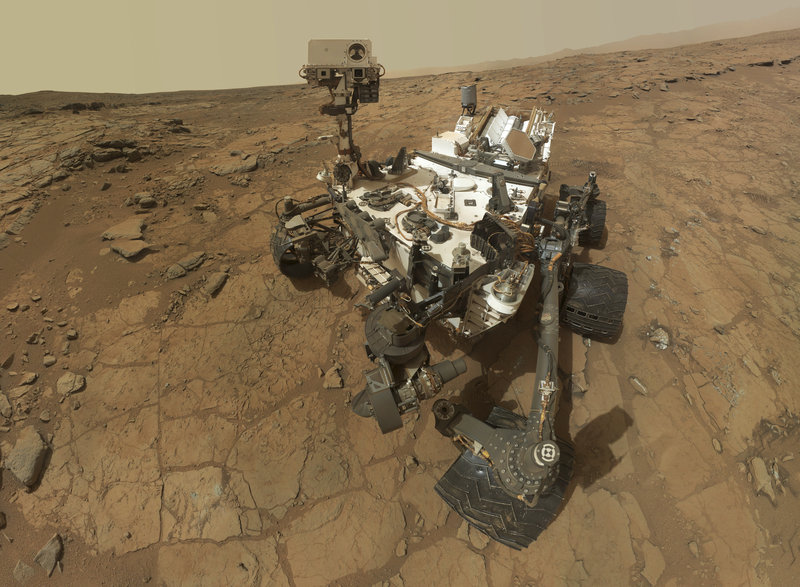A series of discoveries from NASA’s Curiosity rover are giving scientists a picture of Mars that looks increasingly complex, with small bits of water spread around the surface and an interior that could have been more geologically mature than experts had previously thought.
Curiosity’s formidable arsenal of scientific instruments has detected traces of water chemically bound to the Martian dust that seems to be covering the entire planet. The finding, among several in the five studies published online Thursday by the journal Science, may explain mysterious water signals picked up by satellites in orbit around the Red Planet.
The soil that covers Mars’ surface in Gale Crater, where Curiosity landed last year, seems to have two major components, according to data from the rover’s laser-shooting Chemistry and Camera instrument.
One is a coarse soil with millimeter-wide grains that probably came from the rocks around them; the other is very fine, with grains often a few micrometers in size, the ChemCam data show.
The fine-grained soil doesn’t really match the rocks around it, said Pierre-Yves Meslin of the University of Toulouse in France, who led one of the studies.
But it does seem to match the stuff found at sites where other rovers and landers touched down. That means it’s probably distributed over much or all of the planet, kicked up and carried far in the fierce dust storms that can shroud the planet in a reddish haze.
The researchers say they don’t know where that soil comes from, whether it’s created in many places or has one source that gets picked up and blown all over.
Either way, it’s a handy, naturally averaged sample of the Martian surface, said Indiana University mineralogist David Bish, who led a different study.
Perhaps the most intriguing thing about this fine soil is that ChemCam’s readings detected a hydrogen signal, which could explain why satellites orbiting Mars have picked up a mysterious water signal in the past, Meslin said.
“It’s actually kind of exciting because it’s water yet again on Mars, but it’s in a different material than we had recognized,” said Caltech geologist John Grotzinger, the mission’s project scientist. “So what Curiosity is doing is just demonstrating that water is present in a number of ways. It just adds to the diversity.”
But another study based on data from Curiosity’s Chemistry and Mineralogy tool – part of the dirt-digesting lab in the rover’s belly – found no sign of water in soil samples taken from Rocknest, a sandy dune of a pit stop on the rover’s way to a region dubbed Yellowknife Bay. That’s because CheMin uses X-ray diffraction to bounce high-energy light off of a mineral’s crystalline structure. If the soil isn’t in crystalline form, there’s no way for CheMin to see it.
All this means the hydrogen signal seen by ChemCam must have been coming from the amorphous, or non-crystalline, portion, which makes up a significant minority of the soil, said Bish, who led the CheMin study.
Sure enough, Curiosity’s Sample Analysis at Mars instrument cooked up a tiny sample in its little oven and found that roughly 1.5 percent to 3 percent of the soil was made of water. The scientists think this water may have come from the atmosphere, pulled out of the thin air.
Bish said it was interesting that CheMin found no signs of minerals that formed in water, since looking for such clays was “one of the reasons for going to Gale Crater.”
Inside Gale Crater lies a 3-mile-high mountain called Mount Sharp, whose layers could be rich in clays that hold answers to whether Mars was hospitable to life.
It’s possible that this fine-grained soil is simply too young to have ever encountered liquid water, he said. If so, it would mean that many years passed between the formation of the water-rich clays locked inside of certain rocks and the dusty grains that currently cover the Martian surface.
Send questions/comments to the editors.




Success. Please wait for the page to reload. If the page does not reload within 5 seconds, please refresh the page.
Enter your email and password to access comments.
Hi, to comment on stories you must . This profile is in addition to your subscription and website login.
Already have a commenting profile? .
Invalid username/password.
Please check your email to confirm and complete your registration.
Only subscribers are eligible to post comments. Please subscribe or login first for digital access. Here’s why.
Use the form below to reset your password. When you've submitted your account email, we will send an email with a reset code.